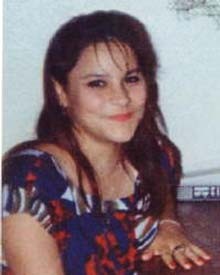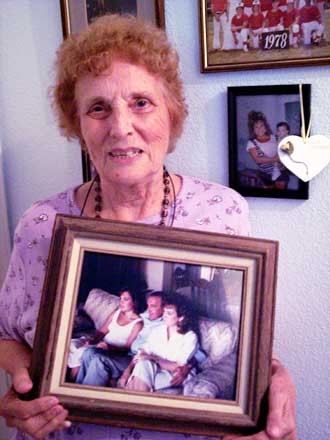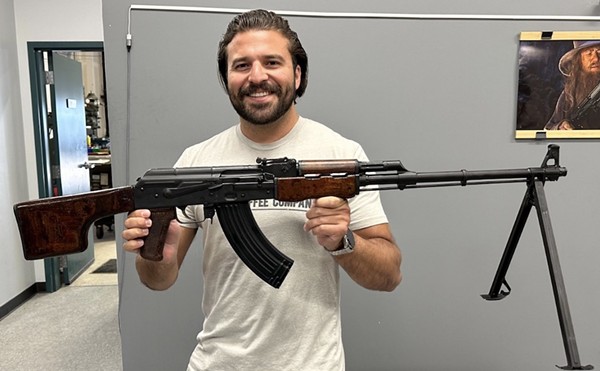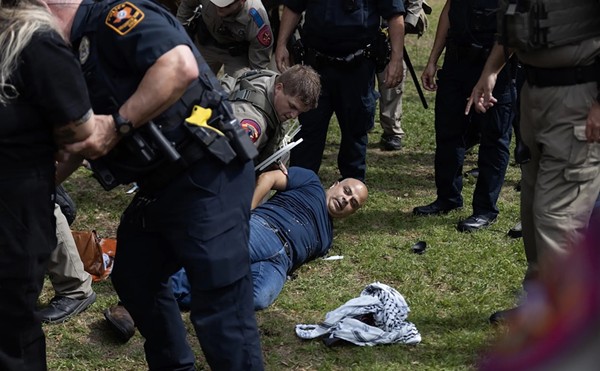The 15th anniversary of Heidi Seeman's murder is a reminder of Bexar County's 1,600 cold cases, some more than 50 years old
February 12, 1993 was a work day for Sheila Smith-Ramirez, so the best she could do was to walk her 15-year-old daughter, Emily García, who was three months pregnant, to the bus stop that morning.
Emily had a doctor's appointment to discuss prenatal care. She was in and out of trouble, and on probation, but on this morning she cooperated with her mother and boarded the bus. She never made it to the doctor's office. Later that night, San Antonio police officers told the frantic mother that she had to wait 48 hours before she could report her daughter missing.
| Emily Garcia |
On February 23, 1993 a road crew clearing brush on Old Cranes Mill Road near Canyon Lake found the nude body of a young female who had a baby boy in her womb. Investigators determined she had been tortured, sexually assaulted, strangled, bound with rope, and dumped along the roadside. There were no personal items, clothing, or identification on the body that had been discarded eight to 10 hours earlier, so Emily was listed as Jane Doe, and was buried in a pauper's grave in New Braunfels.
More than a year later, one of Sheila's friends watched an unsolved crimes news segment, and recognized the backward numeral four that had been tattooed on one of Emily's hands. Sheila was now living in Missouri, but she returned to Texas with Emily's fingerprint card. After her daughter was positively identified, her body was exhumed and buried in the family cemetery in Somerset.
Emily's case remains unsolved. She is one of many homicide victims whose killers have never been brought to justice. In most cases, the victims' corpses were found and autopsied, and evidence was collected by the Bexar County Sheriff's office, San Antonio Police Department, or other law enforcement agencies. For lack of witnesses or enough solid evidence to connect suspects to these crimes, the cases have gone cold.
Two of the City's most famous cold cases are those of 11-year-old Heidi Seeman and 7-year-old Erica Botello. Heidi was abducted 15 years ago on August 4, 1990 as she walked along Stahl Road after spending the night at a friend's house. Erica was snatched outside her residence at the West End Baptist Manor Apartments on West 35th Street on August 23, a day after Heidi's body was found on a ranch near Wimberley. Both cases were high profile, as thousands of volunteers who had organized to search for Heidi also turned their attention toward finding Erica. Both had been sexually assaulted, then strangled and discarded by their captors. Suspects were named in both homicides, but in Heidi's case, there was not enough evidence for a conviction. One man accused of murdering Erica was deemed mentally retarded and incompetent to stand trial, and was sent to San Antonio State Hospital. Another suspect provided an alibi that he was at work during the time of the abduction, and a third was released for lack of evidence.
Heidi Seeman's murder was the catalyst for the founding of the Heidi Search Center, which last Thursday organized a memorial walk to commemorate her 26th birthday.
SAPD Detective George Saidler is currently assigned to investigate Heidi's murder. He has been on the force since 1975, has worked in the homicide division since 1992, and in 2000 was assigned full-time to cold cases. A second detective was added to the SAPD cold-case squad in 2002, and a third was assigned part-time in 2005. While the sheriff's office lists 15 missing persons and cold homicide cases on its website and SAPD lists 47, there are 1,600 cold cases dating back to 1952. Police have reviewed hundreds of cold cases during the past 15 years, and since 1996, solved more than 20.
"I guess some of it is luck, and sometimes time is on our side," says Saidler. "DNA has been extremely helpful ... and witnesses have decided to come forward, and we have confronted suspects on some things (they) had done. There are any numbers of ways these cases are solved."
| Heidi Seeman |
Saidler says a homicide case goes cold when a detective is transferred to another department, and a case is more than a year old. "Normally when they come to us, there are things that lead to a quick resolution, such as a smoking-gun eyewitness, or hardcore evidence that has already been looked into. We are always looking for minute pieces of evidence, to give us that one little lead to a suspect."
Saidler says the cold-case squad investigates all unsolved murders: From an innocent child snatched from her yard to gang members, whose lifestyle led to their demise. "As far as we're concerned, we don't care. We file cases on bad drug deals, street hookers. Nobody has the right to take anybody's life."
Time can work for or against detectives working on cold cases. One example is the murder of Gladys Ramirez. The police and fire departments were summoned to a house fire in April 1980. Once the flames were extinguished, investigators found her burned body, but soon discovered she had been stabbed and strangled. They ruled her death a homicide.
Twenty-four years later, a former San Antonio resident read about the case on the SAPD website, and called police. The witness identified Gladys' spouse, Jose Angel Ramirez, as the murder suspect. He was arrested in October 2004 and is awaiting trial.
Bexar County Sheriff's detectives solved the case of 28-year-old Alma Salazar, who was abducted, raped, murdered, and dumped in the Medina River at Applewhite Road. A DNA sample collected from Julian Lassere Jr. in 2000 was linked to the murder through the National Combined DNA Indexing System. The DNA sample collected from Lassere while he was in jail led to his capital-murder indictment in October 2004.
"Some of these cases we reopened, and we have time on our hands. When we investigate, we know they're 20 years old, with no leads, and nobody coming forward," says Bexar County Sheriff's detective Ruben Arévalos.
Yet, the sheriff's cold-case team remains determined to solve cases, even old ones. "We start finding these witnesses who forget they were scared, had a fear of retaliation from suspects. They don't have that fear anymore. With the Natalie De Leon case (a 16-year-old who was murdered after hitchhiking on Highway 46 near Canyon Lake) we have identified a lot more witnesses than those back in the 1980s. We will not stop and put them aside, we continue to work with these cases."
But time also works against cold-case investigators. Arévalos says in some of the 20-year-old cases, semen samples and skin cells collected from the crime scene cannot provide enough DNA to be tested or have degraded over the years. "If we had had that technology back then, but of course we didn't," says Arévalos. "Sometimes we have only one shot, and if we use it up, we can't get any more. There are other tests that will be developed in the future when there might be a possibility to get DNA profile out of evidence. We need the technology to improve somehow, and we will wait on it instead of destroying the evidence. There are instances where we don't pursue it, we wait."
| "A lot of people don't want to get involved, they want to stay away from the situation, and don't want to talk to the police." - Detective Ruben Arévalos |
Arévalos says the wait can be frustrating. Investigators might have a suspect, but not enough evidence to solve the crime and win a conviction. Maybe the suspect chooses to remain silent, or witnesses are afraid. "A lot of people don't want to get involved, they want to stay away from the situation, and don't want to talk to the police."
Muriel Perry feels that frustration.
Muriel and her grandchildren, Michael and Nicole Blaskoski, were coping with the news that their father, Robert Blaskoski, had gone missing in Chattanooga, Tennessee, after he met Donald Ray Ford at the airport after he returned from a job in Arizona. Authorities couldn't charge Ford with murder because Blaskoski's body hadn't been found. But Ford was convicted for stealing more than $72,000 from Blaskoski's bank and investment accounts and sentenced to eight years in prison. He was paroled after four years.
On December 13, 1996, the family was blindsided by another tragedy: Muriel's youngest grandchild, 27-year-old Noelle Blaskoski, was found dead in her room at the Oakview Motel. Noelle had rented the room only two weeks earlier, and told neighbors she was saving money to move back to Houston. Blaskoski was a dancer at the Wild Zebra strip club on the Northeast Side.
The motel manager found the door ajar, and saw the Noelle on the floor of her room wearing only a black T-shirt. Her hands were bound. The television was blaring, and her car remained in the parking lot. The medical examiner determined her death was caused by "manual strangulation."
Muriel says she was irked by the frequent turnover of detectives on her granddaughter's case. "In five years, we had six detectives. I would call each new detective, they would act surprised that they had the case."
Muriel also says she could feel a coolness over the telephone whenever a new detective reviewed Noelle's case. "I knew they were thinking, 'what do you think when she worked at that kind of job?'"
| Muriel Perry holds a photo of her two granddaughters and her son-in-law. From left, Nicole, her father, Robert, and Noelle Blaskoski. Robert Blaskoski is believed to have been murdered in 1994 in Chattanooga, Tennessee. His body was never found. Noelle was found dead in her motel room in 1996 in San Antonio. Perry joined the San Antonio Chapter of Parents of Murdered Children after Noelle's death. (Photo by Michael Cary) |
But there was more to Noelle than what appears in the police report. "She wasn't the easiest person to get along with," Muriel says. "I'm sure she did her share of drugs and her share of drinking. She was a free spirit ... very independent. Every family has someone who is completely different from everybody, that was Noelle."
Muriel says Noelle's motel door locks were broken the night she was murdered, and she believes the motive was robbery. The autopsy revealed no drugs, liquor, and she wasn't sexually assaulted. And she believes the police have overlooked some important, but missing, evidence.
"The week before she came over to my house for dinner, and she was dressed very nicely in a new ruffled blouse, new pants, and new shoes," says Muriel. "The odd thing is that when they (police) gave us a cardboard box with all of her stuff, including jewelry she had purchased from her sister, Nicole, and more jewelry that her father had given to her, none of the new clothes were in the box. I think it's possible that a woman was involved; a man wouldn't be interested in those things."
When Muriel asked to review the evidence that SAPD investigators retained in the case, there was no jewelry or new clothing.
Muriel has coped with her sorrow over the untimely deaths of her son-in-law and her granddaughter by joining the San Antonio Chapter of Parents of Murdered Children, where after six years as a member, she now serves as the chapter's secretary. She also underwent training as a group counselor for the monthly gatherings of the support group.
Even as she disapproved of Noelle's occupation as an exotic dancer, she says she did not deserve to die. "She was full of joy. Her name was a reminder of the holidays."
Meanwhile, Detective Arévalos remains determined to keep plowing through the pile of the cold homicide cases in San Antonio and Bexar County. "We're not going to sit on our hands. Anybody walking on the streets, who has committed a murder, might get a knock on their door. We're going to put these guys in jail." •
By Michael Cary





















